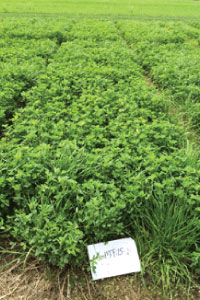Grasshance
Grasshance® (verb) - Improve your forage production by introducing improved DLF grass varieties to an existing forage crop or by mixing DLF grass seed with non-grass forage crop seed in new plantings.
CLICK HERE for our Grasshancer Product Guide.
CLICK HERE for our Grasshancer Tri-Fold.
CLICK HERE for our Maximizing Forage Production Flyer
The methods to improve thinned out stands of forage crops can be seen as rescue measures, but also as a maintenance procedure to maintain maximum yield from your forage crops and in doing so stretch the economical life of the stand.
Interseeding - Planting a different species into an existing stand. You can Grasshance your alfalfa by interseeding a festulolium to increase production while maintaining quality.
Overseeding - Planting new and improved varieties of grass into an existing stand of grass.
(The picture shows an alfalfa stand Grasshanced with Perseus festulolium 4n. Interseeded after alfalfa establishment)
Assess your pastures and hay fields to determine if your forage expectations are on track. Plants may be brown and dormant, but you can still assess their health. Check the roots in early spring. Healthy roots should be an off white color, if they are dark and discolored, you may have problems. Start planning now. Research in the UK and Belgium confirms the value of grassland renewal through Grasshancing; up to a 16% increase in dry matter.
The threshold level for an alfalfa stand is 5 healthy plants or 40 stems/square foot. If your density is greater, good management may be enough. If you are at this level or less, then you need to increase stand density. The solution will be dependent on your crop rotation requirements.
If you need an additional 2 to 3 years before replacing the stand, consider Grasshancing with a DLF ryegrass type festulolium. It will establish quickly, producing high quality forage, and be the highest yielding option for the remaining life of the stand.
If you need just one more year out of the stand, then a true Italian ryegrass may be the best option for Grasshancing. True Italian ryegrass needs to vernalize in order to produce seed heads. A late spring planting will remain vegetative throughout the growing season, producing a large quantity of high quality forage. Adding ryegrass type festulolium to the Italian ryegrass is another option. The deeper root structure of a festulolium helps to minimize a summer slump.
If stand loss is significant, you need to evaluate your long term forage needs. Replacing the alfalfa stand with a ryegrass type festulolium/red clover combination provides a high yielding grass-legume stand and avoids the potential of alfalfa autotoxicity.
For a long term forage option consider a tall fescue type festulolium partnered with alfalfa. Or consider using a ryegrass type festulolium as a nurse crop option.
Evaluate your stand. Early spring and early fall are the time to make Grasshance decisions.
